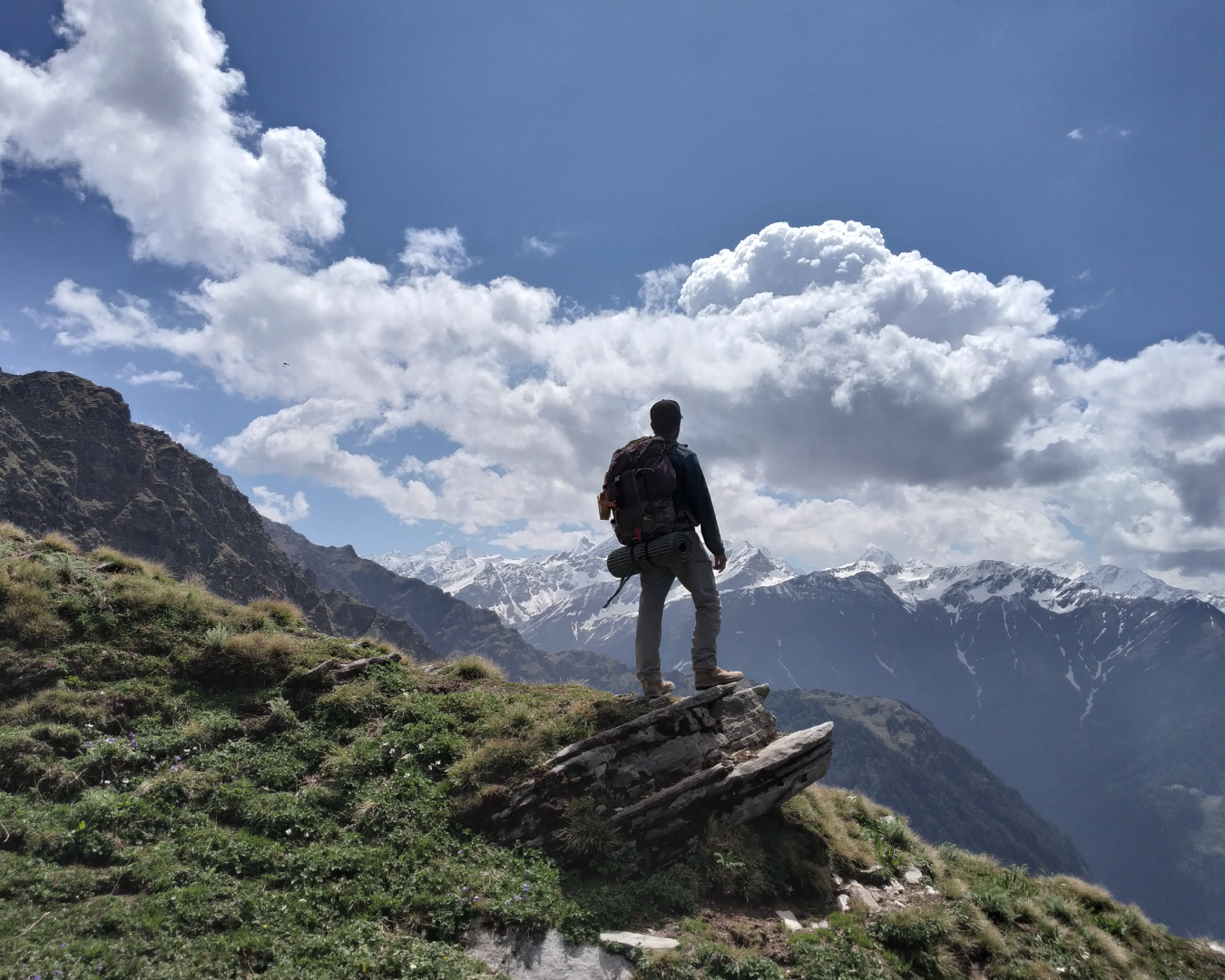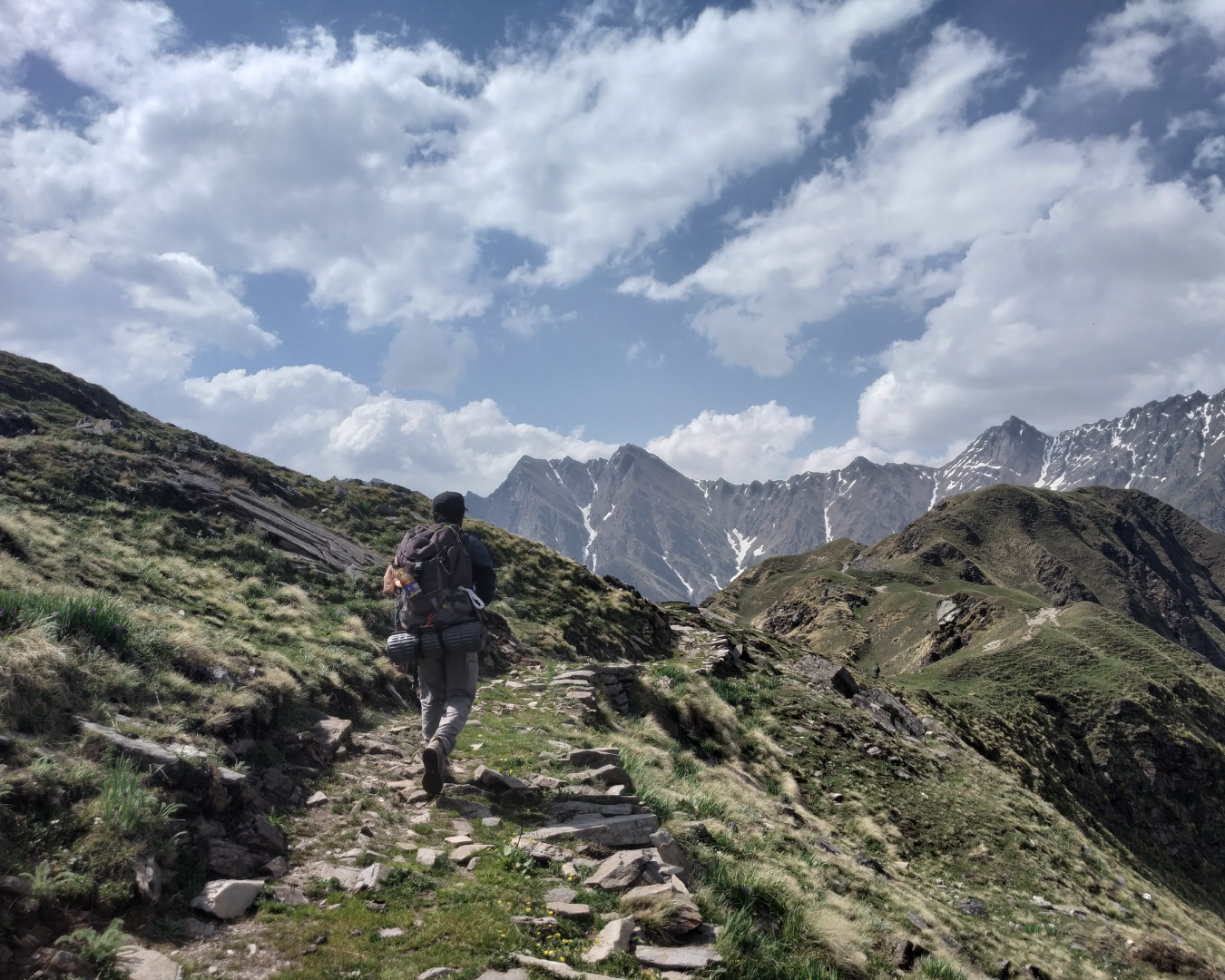Brief Description
Mount Kinner Kailash is located in Kinnaur Valley of Himachal Pradesh. It is one of the 5 mount Kailash and is believed to be the Abode of Lord Shiva. It is said that Lord Shiva regulated the Universe from Mount Kinner Kailash. Mount Kinner Kailash holds a religious significance among the Hindus because of the huge "SHIVA LINGAM", which is a 79 feet vertical rock formation that looks like a Shivlinga. Earlier the Parikrama ( Circumbulation ) was of 200 km, But now the route is been shortened, We will perform this trek in Clockwise direction. This trek is very tough and best meant for spiritual and adventure passionate. Trekking to Kinner Kailash is very rewarding and challenging for experienced trekkers.
Itinerary
Itinerary
Show complete Itinerary
Shimla - Sangla (9-10 Hrs)
Arrive in Shimla by 7 AM. Drive to Sangla Village, at a distance of 220 km from Shimla, in the Baspa Valley also referred to as the Sangla valley, in the Kinnaur District of Himachal Pradesh, close to the Tibetan border. Located at the center of the Baspa valley, Sangla is the locus of many exploration and trekking trails. Our trek starts from here as well. Overnight in the Tourist Rest House or a hotel.

Sangla - Thangi (5-6 Hrs)
Drive along the Sutlej Valley to Thangi (2760 Mts) via the district headquarters at Recong Peo. Thangi is a small village in the Kinnaur district. At an altitude of 2966m, Thangi is the starting point of our trek. Overnight in tents.

Thangi - Lambar (4-5 Hrs)
Trek through some beautiful alpine scenery to Lambar (2890 Mts). Parts of the trail pass through a grand gorge. Lambar is a pretty village located on top of the gorge. Soak in the views and the adventure that you are about to embrace in the next few days. Overnight in tents.

Lambar - Charang (6-7 Hrs)
We gain almost a lot of height this day and camp at the substantially large village at Charang (3500 Mts) which is named after the pass of the same name. On this day we along the rivulet and natural forests to camp near a stream. Charang is known for Rangrik Tungma Complex, an 11th-century monastery. Explore the splendid surroundings and retire for the day. Overnight in tents.

Charang - Lalanti (4-5 Hrs)
Today's trek from Charang to Lalanti will cover a total distance of 8km. The pastures around Lalanti (4420 Mts) are visited by shepherds in the summer months, same as other high altitude meadows in the Himalayas. Lalanti is blessed with beautiful meadows and high altitude flowers. Camp nearby the stream and rest for the night. Overnight in tents.

Rest and Acclimatization
At a staggering altitude of 17198ft, The Charang La is a very high altitude pass and acclimatization is a must. The difficult terrain along with the height of the pass will test any experienced trekker. Hence sufficient rest is an absolute must. Overnight in tents.

Lalanti - Charang La- Chitkul (8-9 Hrs)
After breakfast start the ascent towards the Charang La (5260 Mts). Today's trek will be the longest and the most difficult. The trail is demanding but spectacular views from the top of the Pass are almost assured. After a long and steep climb to the top of the pass, you are presented with spectacular views of the Kinner mountain range and many other virgin peaks. The descent from the top is quite steep to reach the village of Chitkul, the last Indian village before the Indo-Tibetan border. Overnight in tents.

Chitkul - Rakcham (3-4 Hrs)
Trek along the Baspa River to Rakcham. Rakcham is a small village of nomads sandwiched between the villages of Sangla and Chitkul. The valley is scenic and the culture of this lost valley can be appreciated. Overnight in tents or guest house.

Rakcham - Shimla
Drive for about 9 hours to reach Shimla by the evening. One can opt to stay in Shimla for a day or there is option to take overnight Volvo bus from Shimla to Delhi
Frequently Asked Questions
Pick your question
Eligibility: Is this trek good for me?
The Kinner Kailash trek is a tough trek reaching a height of 5260M and not recommended for beginners. A prior trekking experience above the altitude of 4000m is essential along with a good level of fitness and stamina. This trek is appropriate for the seasoned trekkers and for those who have done moderate level treks before. However, if you are a beginner but committed to preparing, then you need at least 2-3 months to prepare physically & mentally for this trek. For details on trek difficulty level, please read on Bikat Rating Scale.
Eligibility: Experience required
Should have at least 7-10 trek days in the Himalayas in their kitty along with the experience of trekking at altitudes of 4000-4500 meters or above.
Eligibility: Requisite skills
How to use basic mountaineering equipment like gaiters & micro spikes
Ascending & Descending on snow
Basics of Mountain Sickness
Basics of Mountain Hazards
How to cross small water streams
How to cross large water streams
Basic principles of acclimatization
Eligibility: Fitness benchmark
- Jog/Run for 5 Kms in 25-30 mins or Walk continuously for 10 kms (with 3-4 small breaks) on plain terrain (slight incline is better) - You would be required to produce a screenshot from a fitness app testifying the same
- Hold your breath for 30-35 seconds
If you are not meeting these benchmarks, please use the preparation schedule to improve your fitness till you achieve the above benchmarks.
About the activity: Why should I go for this trek?
Kinner Kailash Trek
Mount Kinner Kailash holds a religious significance among the Hindus because of the huge "SHIVA LINGAM", which is a 79 feet vertical rock formation that looks like a Shivlinga. This trek combines a difficult gradient with the spiritual reward of the trek and is a must do for any experienced trekker looking for a different experience.Best Season: What are the best months to visit this trek?
Best months to do the trek is in the months of May to September
Packing List: What to pack
Click here for packing list.
Packing List: How should I pack my rucksack?
Packing List: How should I select my trekking shoe?
Connectivity: How to Reach the base of the trek & how to go back from the end point?
The base of the trek is the pretty village of Sangla which is around 230km from Shimla. You can either opt for transport to Sangla from Shimla with us or hire a private taxi. Alternately, you can take a bus from Shimla to Sangla.
By Air: Shimla is well connected to Delhi and other cities of India by air. Air India runs a daily 7:45 am flight from Delhi to Shimla. You can also fly to Chandigarh or Delhi and take a taxi or bus to Shimla from there.
By Rail: If you are traveling by railways, then Kalka is your station. From Kalka, drive to Shimla which is an hour and a half journey. Buses and private taxis are easily available on this route.
By Road: There are daily overnight buses for Shimla from Delhi from Kashmere Gate ISBT and take about 11 - 12 hours.
Connectivity: What is the cellular network connectivity for this trek?
There is a good BSNL and Airtel signal at Sangla. But once the trek starts you will get intermittent network coverage and as we gain altitude there will be none.
Nearby attraction: What are the nearby attractions that I can explore?
Explore the beautiful village of Sangla and its lush green meadows spotted with mud patches and a magnificent backdrop of snow-covered Himalayan Mountains. The Bering Nag temple in Sangla is a must visit as it is considered as one of the most important temples for Hindus. This temple is devoted to Lord Jagas. From Sangla, one can visit the quaint village of Chitkul, the last Indian village before the Indo-Tibetan border. The village of Kalpa and Recong Peo are worth exploring with the famous Kamru fort, which is a perfect place for a glimpse into the artistic legacy of the past. Now converted into a temple, it is dedicated to Hindu Goddess Kamakhya Devi.
Age limit: What is the minimum & maximum age limit?
The minimum age limit is 13 years. However, minors aged between 13 to 17 should be accompanied by their parents or guardians. If you are above the age of 60, kindly carry a medical certificate from your doctor that deem you fit for adventure activities like trekking.
Accommodation:
Accommodation in Sangla and Rakcham will be in a hotel/guest house. The rooms will be provided on twin or triple sharing basis. You will receive the details of your accommodation through email few days prior the trek.
On trekking days, all the trekkers will be accommodated in twin or triple sharing tents. Along with this, there will also be a toilet tent and a dining tent installed at every campsite as we roll.
Equipment and facilities: What kind of tents and sleeping bags will be provided to us?
We provide 4 seasons tents by Gipfel for higher altitudes which can easily withstand heavy snowfall and storms. They are spacious enough to accomodate 3 people at once with a vestibule to place the backpacks. Our sleeping bags are made up of Heatseeker Pro synthetic insulation that can provide you comfort in -10 degrees celsius. We also use additional fleece liners to have thermal efficiency even in the extreme temperatures of -17 degrees Celsius. If you carry your own sleeping bag, you will get a cashback reward provided that you inform us as soon as you have booked your trek.
Equipment and facilities: Are there any washroom/toilet facilities on the trek?
Toilet tents will be provided to you on the trek.These are portable toilets tents where a deep pit will be dug. A shovel will be provided inside the tent to cover the waste after you have made your business. You can take a toilet roll inside. Make sure you dig used toilet paper along with the waste. Though water is recommended in place of toilet paper. Please refrain from using wet wipes as they are non-biodegradable.
There will be no facility for bathing on the trek. Go through our blog section for tips on how to maintain personal hygiene on treks.
Equipment and facilities: If we trek in snow, what equipment will you provide?
You will be provided with good quality gaiters and microspikes from us depending upon the situation of the snow. Our trek leaders will also be carrying ropes and ice axe.
Equipment and facilities: What kind of food will be provided for the trek?
Vegetarian food will be served throughout the trek. The only non-vegetarian item served on our treks are eggs. Our kitchen staff follows a proper menu for breakfast, lunch and dinner which has been designed in order to fulfil the nutritional requirements of the participants. There will be milk, poha, eggs, muesli/corn flakes, bread and butter served for breakfast. Rice or simple roti sabzi will be packed for lunch. In dinner, you will have dal, egg curry or any other vegetarian dish along with rice, roti, and a dessert item. Packed lunch will be provided to you on the days you are trekking. You are requested to carry your own tiffin box and a mug to consume food. The meals consumed on the journey and arrival day are not included in our cost.
Equipment and facilities: What equipment can I rent from you?
You can rent the following items from us- Trekking Pole, Trekking Shoes, Fleece Jacket, Rucksack
Weather conditions: What will the temperatures be like during this trek?
During the day, the temperature will range from 15-22 degrees celsius. The nights will get cold dropping the temperature to -2 to 5 degrees celsius. The higher the altitude you gain, the colder it gets.
Weather conditions: When will there be snow on this trek?
You are likely to experience snow till May, depending on the amount of snowfall received the previous winter. It is difficult to expect snow post-monsoon season.
Miscellaneous : Is there an option to offload my backpack?
If you want to offload your rucksack, you will have to make a request for offloading a few days prior to the trek through an email so that arrangement can be made in advance. You will be charged per day for offloading your rucksack. In case you decide to offload on the spot, you may have to pay a higher price than usual. However, offloading your rucksack is not recommended since it is not a safe practice.
Miscellaneous : Who will lead us on the trek?
A team of participants will be led by a course certified trek leader and a local guide. All participants are requested to abide by what their leader says. There will also be a team of kitchen staff and porters on the trek. We maintain a 1:8 ratio of trek leader and participants. All our trek leaders and staff have certified training in first-aid and rescue operation.
Miscellaneous : Is the trekking pole necessary?
Yes, trekking pole is necessary. If you don’t want to buy one, you can rent it from us on minimal daily basis charges. You can request the renting link from us.
Miscellaneous : Are there any local stores/shops from where I can shop trekking necessities?
Sangla has a small market. It would be difficult to find anything major there. Minor toiletries are available.
It is advisable not to leave anything for last minute buying.
Miscellaneous : Is it safe for solo woman traveller to trek in Fixed departures?
Yes, it is absolutely safe for a solo woman to travel in fix departures. Women on the trek will be sharing a tent with each other. In case you are the only woman on the trek, you will be given a separate tent.
Miscellaneous : Will you give certificates on completion of trek?
Yes, e-certificates will be given at the end of each trek provided that you completed it. It will bear your name, the trek, and the maximum altitude you achieved on the trek.
Transport: In case we opt for the transport with you, where will you pick us from and where will you drop?
We have one pick-up point: Shimla ISBT. The dropping point remains the same.
Transport: What time will we reach the end point on last day of the trek?
Expect to reach Shimla in the evening. Make your bookings from this point to your destinations in the night, post 22:00 Hrs.
Mandatory documents: What are the mandatory documents required for the expedition?
ID Proof (Soft Copy to be sent to us in Advance & original to be carried) is the mandatory document required for the trek.
Why Bikat
Why Bikat






Learning Experience
- We are an Adventure Learning Organisation first.
- We want you to not just complete a trek safely but also pick up some basic trekking knowledge and skills along the way.
- To achieve this we have integrated learning modules into our itineraries.
- These modules will help you build the necessary skills to progress from trekking to mountaineering over time.
Loyality Programs
Our community is an integral part of us and we take pride in our trekkers and climbers. When you complete at least three days on any trek or expedition with us, you become eligible for our membership and referral programs.
- Currently we have three levels:
- Basic Membership
- Summiteer Membership
- Leader Membership
Personalized Attention
- Our group sizes on treks don’t exceed 15 members in order to maintain a healthy Participants : Leader Ratio of 8:1.
- Over time we have found this number to be optimum when it comes to ensuring personalised attention to every member of our group.
- On mountaineering expeditions this number is even smaller. Our group sizes are capped at 12 members ensuring a Participants : HAP Ratio of 2:1.
Best Expedition Leaders
- Our Expedition leaders are advanced mountaineering course qualified, specially trained in rescue procedures from NIM and certified first-aid responders.
- Even our local guides are certified first-aid responders.
Eco-friendly Practices
- Group sizes are capped at 15 people.
- Batch sizes are capped at 250 people per trail per season.
- We follow a rolling campsite model.
- We are constantly exploring and introducing new trails to reduce the burden on existing ones.
Safety
For us, a successful summit is not about reaching the highest point of a mountain but about making it safely back to base.
- To ensure this:
- Every region of ours is mapped with an emergency evacuation plan.
- The equipment we use is UIAA certified.
- Our trek leaders are AMC certified with specialisation in rescue procedures.
- Our support staffs are trained in first aid as well.


Reviews
What's Included
Whats Included
Whats Not Included?
Cancellation Policy
Cash Refund
Cancellations up to 30 days prior to departure date
5% Deduction
Between 30 days to 15 days prior to departure
50%
deduction
Less than 15 days of departure
No Cash Refund
Voucher Refund
Cancellations up to 5 days prior to departure date
No Deduction
Cancellations less than 5 days prior to departure
No Refund
Please note
- Cash refund is applicable only in case of bookings made without using any promotional offer code or vouchers.
- This is only a brief of cancellation terms. For finer details please refer Detailed Cancellation Policy.
Blog Posts

How to Choose the perfect pair of Trekking Shoes?
Sarthak Madan 21 May 2021
<p><span style="color: #000000;">Your choice of trekking shoes can make your trek a blissful or blister-full experience based on how well it fits you. A good pair of trekking shoes is the most essential piece of equipment you will use while hiking.&n
Read More








